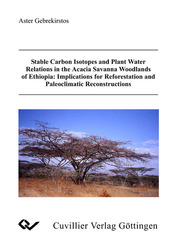| Departments | |
|---|---|
| Book Series (96) |
1378
|
| Nachhaltigkeit |
3
|
| Gesundheitswesen |
1
|
| Humanities |
2363
|
| Natural Sciences |
5406
|
| Mathematics | 229 |
| Informatics | 319 |
| Physics | 980 |
| Chemistry | 1363 |
| Geosciences | 131 |
| Human medicine | 243 |
| Stomatology | 10 |
| Veterinary medicine | 108 |
| Pharmacy | 147 |
| Biology | 835 |
| Biochemistry, molecular biology, gene technology | 121 |
| Biophysics | 25 |
| Domestic and nutritional science | 45 |
| Agricultural science | 1004 |
| Forest science | 201 |
| Horticultural science | 20 |
| Environmental research, ecology and landscape conservation | 148 |
| Engineering |
1791
|
| Common |
98
|
|
Leitlinien Unfallchirurgie
5. Auflage bestellen |
|
Advanced Search
Stable Carbon Isotopes and Plant Water Relations in the Acacia Savanna Woodlands of Ethiopia: Implications for Reforestation and Paleoclimatic Reconstructions (English shop)
Aster Gebrekistos (Author)Preview
Table of Contents, Datei (42 KB)
Extract, Datei (82 KB)
The savanna woodlands, which were estimated to cover 30% of the total land area of Ethiopia, are inhabited by economically, environmentally and socially valuable plant and animal species. However, vast areas of the savanna type vegetation are being destroyed due to anthropogenic interferences. Restoration/reforestation of large areas of degraded lands is a major challenge faced in Ethiopia today. Lack of knowledge, on site – species matching (exotic species), led to failure of most of the attempted reforestation programs and lack of information on the ecology and ecophysiology of indigenous species limited their use in reforestation projects. Despite prevailing harsh environmental conditions, naturally occurring tree and shrub species in the savannas have survived with the help of adaptive traits, which they have acquired due to long term exposure to ecological stress. Therefore, this study was carried out to find the answers for the following questions: i) could these adaptive traits be identified and manipulated to provide a basis for selecting important tree species suitable for rehabilitation/reforestation of degraded lands? ii) Do some of these species compete favourably for scarce resources and grow well in mixed communities? iii) To what extent does land degradation as a result of natural or anthropogenic interferences disrupt ecophysiological stability and lead to poor adaptations? and iv) What are the climate-growth relationships in the savanna woodlands?.
| ISBN-13 (Printausgabe) | 3865377645 |
| ISBN-13 (Hard Copy) | 9783865377647 |
| ISBN-13 (eBook) | 9783736917644 |
| Language | English |
| Page Number | 156 |
| Edition | 1 |
| Volume | 0 |
| Publication Place | Göttingen |
| Place of Dissertation | Göttingen |
| Publication Date | 2006-02-19 |
| General Categorization | Dissertation |
| Departments |
Environmental research, ecology and landscape conservation
|








